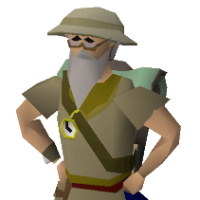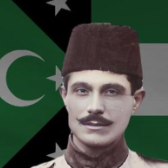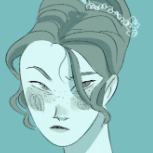-
Posts
164 -
Joined
Reputation
1067 Godly
Contact Methods
-
Discord
meggiebyte#0000
-
Minecraft Username
toffToffee
Profile Information
-
Location
New Zealand
Recent Profile Visitors
2993 profile views
-
Adalfriede would not be able to attend, but she resolved to send a gift to the happy couple. "Josefina," she said to the girl sitting at her side. "You have a knack for such things. Find a gift for Anselm and Viktoriya, won't you?" @alien_mc
-
MC Name: toffToffee Discord: @meggiebyte Image: Description of Image: The Prince and Princess of Minitz sitting on thrones. Dimensions: 1x1
- 1 reply
-
3
-
DIE KRONJUWELEN VON REINMAR | THE CROWN JEWELS OF REINMAR
Toffee replied to crazedpudding's topic in Royal Court
Princess Adalfriede pored over the fine work of Frederica and Juliya, a rare, soft smile on her lips. So many relics in their Princely House, with no doubt more to follow in the prosperous years ahead. "Rest with GOTT, Duchess. In your work, you are immortal." -
finally. bring back the runelords
-
Toffee started following KRETZENFEST and Paper
-
Adalfriede knelt before the statue of Wilheim and Josefina, the play of water from the fountain quiet and melodic. A fallen leaf spun in the current and washed up against the pale stone. The stonemason had not quite managed to capture the late Duchess’ likeness, for hard stone could not radiate quiet strength and a glimmer in the eye as she had. Adalfriede removed the crown nestled over her veil. The Diadem von Minitz. Sunlight spilled through the sapphires and emeralds, casting bright gemdrops of colour across Adalfriede’s robes and the carefully tended flagstones. When Josefina had first given her the crown, they had been standing in the centre of camp, the city of Kretzen barely anything more than loose piles of stone and wood. Such a thing of beauty had seemed out of place in the ruggedness of the camp, yet looking at it now, the crown had its own brutal elegance, each tip sharp enough to skewer a man. One of mea finest pieces, if Ea do say so meaself. Vy deserve something that will match vyr own brilliance, and that will match the brilliance of our family. A shining crown for a shining jewel in the hearts of the Reinmaren. Glancing up into her stone face, the ghost of Josefina’s soft, wrinkled fingers caught on Adalfriede’s chin and sent a chill down her spine. Wind vibrated through the branches overhead, turning into the old woman’s quiet hum. Wear it with pride, dear child. Ea see magnificence in vy. Let it grow. Just remember to visit me when Godan decides mea time is near, hm? Adalfriede angrily dashed a tear from her cheek with the back of her hand. She had not visited. Why? The city of Kretzen reached its brick and tile fingers to the heavens, ensconcing Josefina in what would be her tomb, but she seemed too timeless to ever die. A dobry consort is a silent one who does her duty nie matter the price she has to pay. Ea was very young when Ea met Wilheim, vy know, a girl of but twelve, nearly eight decades ago now. Ea did niet feel Ea had the right to use his name or exercise his power or claim his honour as mea own, even though all those things were rightfully mine as his wife. And still, when mea dear Manfred took up the mantle, and Ea held the bowl into which he dripped his blood as he became Chief, Ea felt that as his mamej, Ea had nie right to make mea will heard, that Ea should merely be a support to him as Ea had always been. And he was wonderful and patient and kind, blunt and stubborn, da, but wonderful. All Ea can do is guide, though mea words are so often taken for granted. It is a symptom, vy see, of princedom and kingship alike. The koeng of Haense has wept in mea arms, and mine was the hand that fed and raised Manfred to the point where he could raise a family himself, with Ravenna. The plight of the mother is to live in the shadows of vyr children, and their children. And how wonderful those shadows feel, even when vy are long forgotten, and vyr words are but distant whispers in the wind. Ea only hope that, when Ea am gone, they will be able to survive without mea guidance. Adalfriede slowly rose, brushing the gravel from the folds of her gown. She was not a silent consort, nor one who was afraid to represent her husband’s honour. She ran a hand over the golden brooch clasping her tribesman’s cloak, feeling the careful engraving of a shield maiden on horseback, Reinmaren runes chased in silver spiralling along the edges. Josefina had had a woman’s strength, quiet and unyielding, weathering life as gracefully as an ancient oak at the heart of a great forest. Promise me something, won't vy, dear girl? When Yam gone, and niething more than a memory, watch over them for me. Love them all as vy love vyrself, and they will take care of vy, even if there are bumps in the road. Unclasping the cloak from around her shoulders, Adalfriede draped it around the stone likeness of Josefina. Raevborne yet Reinmaren to the bone, Josefina would bear the gold brooch of a Chieftess of the Reinmaren in death even if she had not seized that honour for herself in life. Adalfriede smoothed out the green fabric with a tremulous smile, foreign on her usually icy features. “I promise.”
-
This looks really fun! I would definitely be keen to play a character in this niche
-
Princess Adalfriede polished the armour of the Auserwal, rendering it to a high gleam. No doubt by the end of this it would be splattered with the blood of the enemy; if they even took to the field.
-
Princess Adalfriede lamented that she would be unable to attend, but she set about preparing gifts for them both!
-
The Princess Adalfriede diligently lacquered her shield, the ever-pious St. Julia of Paradisus engraved in immaculate detail on the heavy wood. No doubt before the end of this her shield would be chipped and marred from combat, but the symbol would forever remain.
-
THE BEGINNING OF THE SECOND KRETZENFEST DAS ZWEITE KRETZENFEST | THE SECOND KRETZENFEST Issued by the Princess of Minitz and the Baroness of Sigradz In the year of our Lord 1970 ÖHNE UND TÖCHTER VON REINMAR, OVER A CENTURY AGO, the Reinmaren people observed the first Kretzenfest at Wilheburg, held by Saint Prince Johann Barclay to celebrate the harvest. An ode to centuries-old Reinmaren fortitude throughout the harshest of winters, Kretzenfest is a festival of determination, as well as a last goodbye to the warm balm of summer. ITINERARY DIE ERNTE | THE HARVEST With the opening of Kretzenfest, citizenry and honoured guests alike are invited to partake in the traditional harvesting of wheat and milling of flour. They shall then go on to bake pretzels and share their work amongst themselves amidst drink and song. To those who seek to complete the Trials of the Stallion and become a blooded son or daughter of Reinmar, this shall serve as their Trial of Humility. A feast shall then be served to mark the official opening of the festival. ERZÄHLKUNST UND MOOT | STORYTELLING AND MOOT The Reinmaren people keep an oral tradition, passing down stories through the performance of skaldic poetry and telling of tales. All shall gather in the theatre to watch a traditional Reinmaren fable performance by Adelmar von Kretzen. Following the performance, Moot shall be held within the Moothall. DER MARKTTAG | THE MARKET DAY A grand marketplace will be constructed in the central square of Kretzen for traders across Aevos to hark their wares, from arms and armour to medicine to delicate needlework. There shall also be a haybale maze to traverse. Can you find your way? Should you wish to reserve a stall, send word to the Princess of Minitz or the Baroness of Sigradz stating the broad genre of your wares and whether you will require a small, medium, or large stall. Brewers and vintners from across the continent are also invited to partake in a drink-making competition. All in attendance will vote on the finest beverage, and the winner will be awarded a contract to provide their drink in great quantities for future feasts hosted by Der Heidehof. The value of this contract is to be negotiated with the Princess of Minitz. INVITATIONS His Holiness, CAIUS, High Pontiff of the Holy Mother Church. The College of Cardinals. The Diet of Bishops. The Clergy of Clement and Evaristus. His Apostolic Majesty, JOHN, King of the Apostolic Kingdom of Aaun and the Aaunic people. His Royal Majesty, IVAN, King of the Dual Kingdom of Hanseti-Ruska and the Haeseni people. Her Royal Majesty, CATHERINE, Queen of the Commonwealth of the Petra and the Petran people. Her Royal Majesty, SYBILLE, Queen of the Kingdom of Balian and the Balianite people. Her Royal Majesty, TAR-CARANETH, Queen of the Kingdom of Númendil and the Númenedain people. OIJIN KATO, Shugo of Sakuragakure and the Oyashiman people. His Highness, JOHANNES, Elector of Merryweather-Alstreim, Lord Vandalore. His Lordship, SIEGMUND VON REUSS, Elector of Velen, Ritterkommandant of the KOV. His Grace, AUREL VON THEONUS, Elector of Marignan. The Honorable, FRIEDRICH VON AUGUSTEN, Elector of Hohengarten. SIR DARIS VERETHI TERES, Syndicate Envoy to the Waldenic Diet. The Waldenian Peoples. His Royal Majesty, ILLTHRAK, Prince of the Principality of Celia’nor and the Celia’norian people. His Majesty, GRELU, Grand King of Urguan and the Urguani people. The Reinmaren Peoples. WER RASTET, DER ROSTET HER ROYAL HIGHNESS, ADALFRIEDE of HEXENWALD, Princess of Minitz HER LADYSHIP, FREDERICA, Baroness of Sigradz, Seneschal of the Heather Court
- 6 replies
-
24
-
Adalfriede polished off her earrings and donned her tribesman's cloak, securing it with a gold brooch chased with silver.
-
The Princess Adalfriede had witnessed the trial and burning of a demon with the sense that its death was only the beginning. Her dark eyes skated over words of the Pontiff's doings and she knew that there was much more to be done before the realm was purged of such disease.
-
The Princess Adalfriede sharpened her spear and readied her shield for the glory of Reinmar!
-
Illynora Sylvaeri remembered a time, twenty years before the shop's official establishment, when a young Jorvin Starbreaker was finding his feet as a smith and as a merchant in the harbour city of Aegrothond. She read over the pamphlet and smiled, resolving to make the trip to Urguan if only to be reminded of times long since passed.






.thumb.png.352eb4102ab2400157bbaaadb1645189.png)







